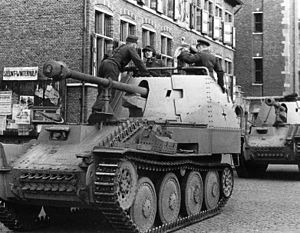This article needs additional citations for verification. (March 2022) |
| Marder III | |
|---|---|
 Marder III Ausf. M | |
| Type | Tank destroyer |
| Place of origin | Nazi Germany, German-occupied Czechoslovakia |
| Service history | |
| In service | 1942–1945 |
| Used by | Nazi Germany |
| Wars | World War II |
| Production history | |
| Designed | 1942 |
| Manufacturer | BMM (ČKD) |
| Produced | 1942–1944 |
| No. built | 1736 produced and converted
|
| Specifications | |
| Mass | 10,670 kg (23,520 lb) |
| Length | 4.65 m (15 ft 3 in) |
| Width | 2.35 m (7 ft 9 in) |
| Height | 2.48 m (8 ft 2 in) |
| Crew | 4 |
| Armor | 10–50 mm |
Main armament | 7.62 cm PaK 36(r) (Sd.Kfz. 139) 7.5 cm PaK 40 (Sd.Kfz. 138 Ausf. H and M) |
Secondary armament | 7.92 mm MG 37(t), MG 34 or MG 42 |
| Engine | Praga Typ TNHPS/II water-cooled, 6-cylinder gasoline, 7.75 l 125–150 PS (123–148 hp; 92–110 kW) |
| Power/weight | 14.1 PS (10.4 kW) / tonne |
| Suspension | leaf spring |
| Ground clearance | 40 cm (1 ft 4 in) |
Operational range | 190–210 km (120–130 mi) |
| Maximum speed | 35–42 km/h (22–26 mph) |
Marder III was the name for a series of World War II German tank destroyers. They mounted either the modified ex-Soviet 76.2 mm F-22 Model 1936 divisional field gun, or the German 7.5 cm PaK 40, in an open-topped fighting compartment on top of the chassis of the Czechoslovakian Panzer 38(t). They offered little protection to the crew, but added significant firepower, which was able to destroy the thick-armored T-34s, compared to contemporary German tanks. They were in production from 1942 to 1944 with three variants, the Marder III, Marder III H, and Marder III M, and served on all fronts until the end of the war, along with the similar Marder II. The German word Marder means "marten" in English.
- ^ Jentz, Thomas L.; Doyle, Hilary Louis (2011). Panzer Tracts No.23 - Panzer Production from 1933 to 1945. Boyds, Maryland: Panzer Tracts. pp. 23, 76.